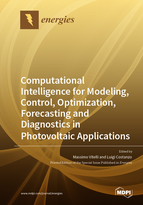Computational Intelligence for Modeling, Control, Optimization, Forecasting and Diagnostics in Photovoltaic Applications
A special issue of Energies (ISSN 1996-1073). This special issue belongs to the section "A2: Solar Energy and Photovoltaic Systems".
Deadline for manuscript submissions: closed (30 June 2020) | Viewed by 58139
Special Issue Editors
Interests: maximum power point tracking techniques in photovoltaic applications; power electronics circuits for renewable energy sources; methods for the analysis, design, and optimization of switching converters; control methods and architectures for the maximization of the energy provided by vibration energy harvesting systems
Special Issues, Collections and Topics in MDPI journals
Interests: maximum power point tracking techniques in photovoltaic applications; power electronics circuits for renewable energy sources; methods for the analysis, design, and optimization of switching converters; control methods and architectures for the maximization of the energy provided by vibration energy harvesting systems
Special Issues, Collections and Topics in MDPI journals
Special Issue Information
Dear Colleagues,
In the last years, a growing number of scientific papers has appeared in the literature on computational intelligence (CI) applied to photovoltaic (PV) systems. CI can be profitably used to carry out the following tasks in PV applications: modeling, sizing and control of stand-alone and grid-connected PV systems, centralized maximum power point tracking (MPPT), distributed MPPT, PV arrays reconfiguration, storage sizing, control optimization, detection of mismatching operating conditions, fault diagnosis, maintenance programming, prediction and modeling of solar radiation, and output power plants forecast of PV systems. This Special Issue aims to:
- focus on the latest theoretical studies, numerical algorithms, scientific results, and applications of CI in PV systems;
- bring together scientists adopting several approaches and working on the above topics;
- promote and share as much as possible top-level research in the field of CI in PV systems.
This Special Issue is open to both original research articles and review articles covering, but not limited to, these topics:
- maximum power point tracking techniques;
- forecasting techniques;
- sizing and optimization of PV components and systems;
- PV modelling;
- reconfiguration algorithms;
- faults diagnosis;
- mismatching detection;
- decision processes for grid operators.
Dr. Luigi Costanzo
Guest Editors
Manuscript Submission Information
Manuscripts should be submitted online at www.mdpi.com by registering and logging in to this website. Once you are registered, click here to go to the submission form. Manuscripts can be submitted until the deadline. All submissions that pass pre-check are peer-reviewed. Accepted papers will be published continuously in the journal (as soon as accepted) and will be listed together on the special issue website. Research articles, review articles as well as short communications are invited. For planned papers, a title and short abstract (about 100 words) can be sent to the Editorial Office for announcement on this website.
Submitted manuscripts should not have been published previously, nor be under consideration for publication elsewhere (except conference proceedings papers). All manuscripts are thoroughly refereed through a single-blind peer-review process. A guide for authors and other relevant information for submission of manuscripts is available on the Instructions for Authors page. Energies is an international peer-reviewed open access semimonthly journal published by MDPI.
Please visit the Instructions for Authors page before submitting a manuscript. The Article Processing Charge (APC) for publication in this open access journal is 2600 CHF (Swiss Francs). Submitted papers should be well formatted and use good English. Authors may use MDPI's English editing service prior to publication or during author revisions.
Keywords
- maximum power point tracking techniques
- forecasting techniques
- sizing and optimization of PV components and systems
- PV modelling
- reconfiguration algorithms
- faults diagnosis
- mismatching detection
- decision processes for grid operators.







